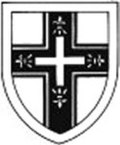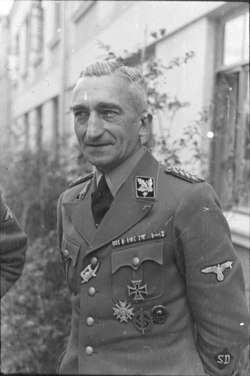Search results
Appearance
There is a page named "Krasnodar Trial" on Wikipedia
- The Krasnodar Trial was a war crimes trial that was held in front of a military tribunal in July 1943 in Krasnodar, Soviet Union. All of the defendants...6 KB (550 words) - 21:15, 7 March 2025
- Krasnodar, formerly Yekaterinodar (until 1920) is the largest city and the administrative centre of Krasnodar Krai, Russia. The city stands on the Kuban...38 KB (3,402 words) - 20:59, 4 April 2025
- York University Press. ISBN 9781479886067. "The people's verdict : a full report of the proceedings at the Krasnodar and Kharkov German atrocity trials"...8 KB (889 words) - 15:29, 25 March 2025
- Soviet prisoners of war War crimes trials High Command Trial Kharkov Trial Krasnodar Trial Minsk Trial Riga Trial Ukase 43 Related articles The Holocaust...17 KB (587 words) - 16:48, 24 December 2024
- Edgar Faure at the Nuremberg Trial. In July 1943, a Soviet military court in Krasnodar held the first war crimes trial of World War II. There were 11...11 KB (1,203 words) - 18:47, 1 February 2025
- Soviet prisoners of war War crimes trials High Command Trial Kharkov Trial Krasnodar Trial Minsk Trial Riga Trial Ukase 43 Related articles The Holocaust...19 KB (1,297 words) - 01:45, 27 March 2025
- Soviet prisoners of war War crimes trials High Command Trial Kharkov Trial Krasnodar Trial Minsk Trial Riga Trial Ukase 43 Related articles The Holocaust...10 KB (967 words) - 17:00, 11 August 2024
- Soviet prisoners of war War crimes trials High Command Trial Kharkov Trial Krasnodar Trial Minsk Trial Riga Trial Ukase 43 Related articles The Holocaust...212 KB (23,070 words) - 22:06, 31 March 2025
- political commissars taken prisoner at the front to be shot immediately without trial. German soldiers participated in these mass killings along with members...179 KB (21,434 words) - 04:48, 5 April 2025
- Soviet prisoners of war War crimes trials High Command Trial Kharkov Trial Krasnodar Trial Minsk Trial Riga Trial Ukase 43 Related articles The Holocaust...6 KB (528 words) - 00:38, 27 January 2025
- Soviet prisoners of war War crimes trials High Command Trial Kharkov Trial Krasnodar Trial Minsk Trial Riga Trial Ukase 43 Related articles The Holocaust...41 KB (4,595 words) - 13:58, 4 April 2025
- Soviet prisoners of war War crimes trials High Command Trial Kharkov Trial Krasnodar Trial Minsk Trial Riga Trial Ukase 43 Related articles The Holocaust...10 KB (1,239 words) - 12:03, 25 February 2025
- Soviet prisoners of war War crimes trials High Command Trial Kharkov Trial Krasnodar Trial Minsk Trial Riga Trial Ukase 43 Related articles The Holocaust...28 KB (2,689 words) - 22:05, 30 March 2025
- their commanders were punished after the war at the subsequent Nuremberg trials for their conduct during the war. The Wehrmacht security divisions were...6 KB (635 words) - 14:26, 31 March 2025
- Friedrich Jeckeln (section Trial and execution)German personnel, he was tried before a Soviet military tribunal in the Riga Trial in Latvia from 26 January 1946 to 3 February 1946. During the investigation...14 KB (1,445 words) - 10:21, 24 January 2025
- Soviet prisoners of war War crimes trials High Command Trial Kharkov Trial Krasnodar Trial Minsk Trial Riga Trial Ukase 43 Related articles The Holocaust...2 KB (211 words) - 15:43, 3 February 2024
- The Riga Trial was a war crimes trial held in front of a Soviet military tribunal between 26 January and 3 February 1946 in Riga, Latvian Soviet Socialist...6 KB (420 words) - 17:33, 9 November 2024
- in the Minsk area. According to testimony presented at Widmann's postwar trial: One of the bunkers was loaded with explosives and 24 mental patients were...32 KB (3,797 words) - 05:14, 4 April 2025
- Soviet prisoners of war War crimes trials High Command Trial Kharkov Trial Krasnodar Trial Minsk Trial Riga Trial Ukase 43 Related articles The Holocaust...40 KB (4,983 words) - 07:12, 3 April 2025
- Soviet prisoners of war War crimes trials High Command Trial Kharkov Trial Krasnodar Trial Minsk Trial Riga Trial Ukase 43 Related articles The Holocaust...5 KB (423 words) - 04:05, 4 April 2025
- Altai Territory, the Zabaykalsky Territory, the Kamchatka Territory, the Krasnodar Territory, the Krasnoyarsk Territory, the Perm Territory, the Primorie
- a TV program about 1963 trial of Nazi collaborators in Krasnodar) Zarokov (Mikhail Tulyev): Who is being tried in Krasnodar? Your friends, relatives
- through parts of the Krasnodar region in southern Russia, officials say. Guānfāng shuō: hóngshuǐ héngsǎo Russia nánbù d Krasnodar bùfen dìqū, chāoguò 130














